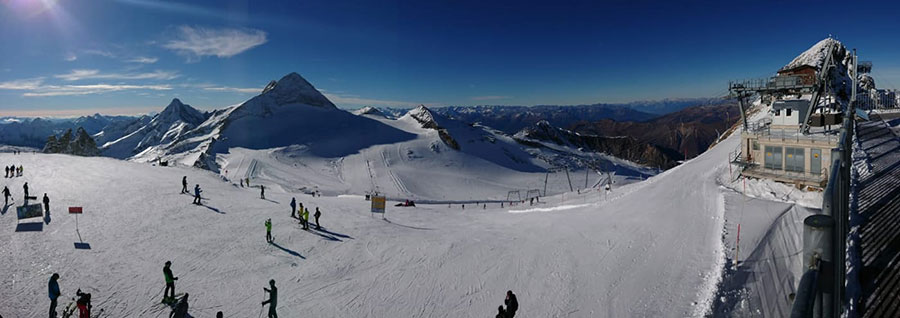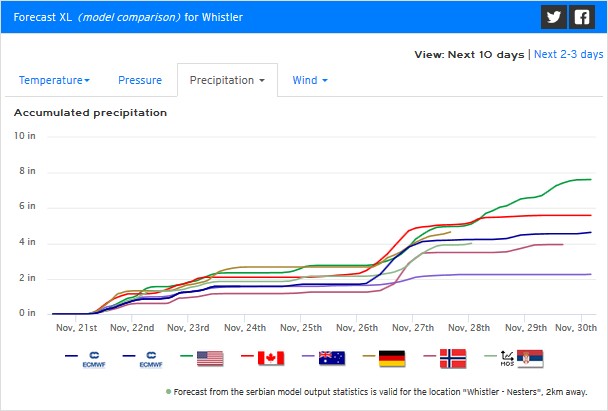
Skiing under a blue sky, Hintertux this week...
J2Ski Snow Report 15th November 2018
Pre-season snow, mixed with autumnal warmth this week, with cold coming into the forecast.
November 15th Snow Headlines
- Obergurgl opens for the season
- Vail opens early for the ski season
- Heavy snow in Quebec
- Canada's ski season underway
- Val Thorens Cancels pre-opening weekend
- Heavy snow in Chile
- Levi and lake Louise OK to stage world Cup races over coming weekends.
It's been the usual Autumn roller-coaster of weather conditions over the past week with the storms that brought up to two metres of snow to high slopes in the Alps at the start of the month giving way to unseasonably warm temperatures for a while (cooler air is forecast).
The main result of this in the short term is Val Thorens deciding to cancel its planned pre-season weekend this Friday.
Across the Atlantic, resorts are continuing to open early for the season with some Colorado resorts already claiming this is the best start to the season there in a decade. Canada's 2018-19 season also got underway at the weekend with four ski areas in Alberta opening.
In the Alpine Forecast
A distinct turn to cold, with the possibility of significant snowfall in the last week of November, is now on the cards for the Alps; with the current high pressure system expected to move North to allow much colder air to push in from the East.
We'll have more detail on that next week; it looks promising, but too far out to be sure at the moment.

See where it's expected to snow this week... (and, yes, that's Greece looking to get some snow!)
Re-publication :- our Snow Report Summary, being the text above this line, is free to re-publish, but must be clearly credited to www.J2ski.com with text including "J2Ski Snow Report" linked to this page - thank you.
EUROPEAN ALPS
Austria
The number of ski areas open in Austria has finally reached double figures with Obergurgl opening for its 18-19 season today (Thursday 15th November). It joins the country's eight glacier areas, most of which have already clocked up six weeks or more of the season, and Kitzbuhel, still operating with snow saved (or 'farmed') from last season.
Obergurgl has 15km of runs open served by about 10 lifts, but several of the glaciers, particularly Hintertux and Solden, have around 20-25km open, so still rather more available high up.
France
Val Thorens reports temperatures too warm and conditions a bit windy so has taken the decision to cancel a planned pre-opening weekend this coming weekend and focus on its main season opening a week on Friday. It reports the snow great above 2700m but a gap between that level and the resort itself.
Chamonix also planned to open this weekend and so far hasn't said it won't be doing so it looks like it and already-open Tignes will be the two choices there this Saturday. A third possibility, Porté Puymorens, opened last weekend in the French Pyrenees, but it is looking less certain it will again this weekend.
Italy
There's little change in Italy either with Solda/Sulden and Val Senales/Schnalstal open plus Cervinia accessing the ski area it shares with neighbouring Zermatt. There's been no fresh snow reported here either but conditions are good in the sunshine. Livigno is set to join the club imminently and reports its slopes in excellent condition.
Switzerland
With the unexpected opening of Verbier at the weekend there are six centres currently operating (although some, including Verbier, currently only at weekends).
Year-round Zermatt and 9-months-a-year Saas Fee have the most terrain open, each with around 25km of runs, but there's also some skiing open on the Diavolezza glacier near St Moritz, on the Titlis glacier at Engelberg and at Glacier 3000 between Les Diablerets and Gstaad. Sunny here too.
Scandinavia
It's been a bit too warm for many new areas to open in Scandinavia this past week either and the tally remains at about half-a-dozen with Narvik and Kvitfjel in Norway, Idre Fjall in Sweden and Levi and Ruka in Finland all open for the season.
Ruka is in to its second month already in fact and Levi is gearing up to host the first races in the FIS Slalom World Cup tour this weekend (with Dave Ryding in action for TeamGB).
Pyrenees
After the snowy start to November which saw Porté Puymorens in the French Pyrenees become the first non-glacier resort to open, and Masella on the Spanish side post its earliest ever opening in its 60 year history, things have warmed up a lot in the Pyrenees. The early cover has largely thawed and it's unclear how much longer these two areas will be able to keep operating before the next snows arrive.
Scotland
Warm weather in the UK has melted most of the early mountain snow cover from Scottish hills and it looks to be staying warm for at least the next week. Three of the five highland ski areas now have all weather snow-making systems in place however so a late November/early December opening of at least some terrain looks likely, whatever the weather.
Eastern Europe
There's been some snowfall reported on high slopes in Romania and elsewhere on the eastern side of Europe but so far no reports of any areas planning to open before December.
North America
Canada
Canada's ski season got underway last Friday with the three Banff resorts of Sunshine, Norquay and Lake Louise all opening, as did 'Calgary's closest resort' Nakiska. A fifth Alberta area, Marmot Basin near Jasper, is scheduled to join them this weekend. Cover is so far rather limited but the fact that Sunshine, one of the few major ski areas in the world still operating without snow-making could open is clearly a good sign.
On the East coast there's been up to 40cm of snow reported in Quebec and several areas are opening this weekend including Mont Saint-Sauveur.
USA
The US continues to enjoy a good start to the season in most areas. More resorts have been opening in Colorado and New England but resorts in the Midwest in states like Wisconsin and Minnesota are also now opening as well as areas in Montana and on the southern side, New Mexico, where they've also had good early snowfalls and snow-making conditions.
Vail has opened early (on Wednesday 14th) after 1.2m of snowfall in the past month there, and we've just heard that Aspen Mountain will open this Saturday (17th November) and Snowmass will open next Thursday (22nd November).



